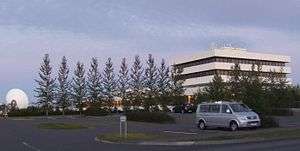RÚV
 | |
| Type | Broadcast radio and television |
|---|---|
| Country | Iceland |
| Availability | National; international (selected programs via the Internet) satellite Thor 5 ends 31 - Thor 6 |
| Owner | Government of Iceland |
Key people | Magnús Geir Þórðarson, CEO |
Launch date |
1930 (incorporation) 1930 (radio) 1966 (television) |
Official website |
www.ruv.is Company information in English |
Ríkisútvarpið (RÚV) (pronounced [ˈriːcɪsˌuːtvar̥pɪð] or [ˈruːv]) (English: 'The Icelandic National Broadcasting Service') is Iceland's national public-service broadcasting organization.
Operating from studios in the country's capital, Reykjavík, as well as regional centres on the country, the service broadcasts a variety of general programming to a wide audience across the whole country via radio channels Rás 1 and Rás 2, and one television channel.
RÚV began radio broadcasting in 1930 and its first television transmissions were made in 1966. In both cases coverage quickly reached nearly every household in Iceland. RÚV is funded by a broadcast receiving licence fee collected from every income tax payer, as well as advertising revenue. RÚV has been a full active member of the European Broadcasting Union since 1956.
Since 1986, the year in which its monopoly as the only permitted domestic broadcaster was ended, RÚV has faced competition from a number of private broadcasting companies, most notably the 365 corporation.
On 31 March 2011, RÚV introduced a major re-branding of its stations, new logos, and a visual overhaul to its television channel.[1]
Programming

RÚV – which by the terms of its charter is obliged to "promote the Icelandic language, Icelandic history, and Iceland's cultural heritage" and "honour basic democratic rules, human rights, and the freedom of speech and opinion"[2] – carries a substantial amount of arts, media, and current affairs programming, in addition to which it also supplies general entertainment in the form of feature films and such internationally popular television drama series as Lost and Desperate Housewives. RÚV's lineup also includes sports coverage, documentaries, domestically produced entertainment shows, and children's programming.
The RÚV newsroom, providing news for both television and radio, is amongst the most time-honoured and respected in Iceland. On weekdays the Rás 2 radio network includes 35 minutes of regional opt-outs for local news coverage.
Gettu betur is a popular annual quiz tournament pitting teams from senior secondary schools around Iceland against each other in five rounds which are broadcast on radio and TV. Also popular viewing is the Eurovision Song Contest, to which RÚV has sent participants on Iceland's behalf since 1986. In sports, RÚV traditionally carries live coverage of such major events as the Olympic Games and the FIFA World Cup, although it lost the right to broadcast the 2006 World Cup, having been outbid by commercial broadcaster 365 in 2002. It did, however, show the 2010 World Cup tournament.
Special services

In accordance with its duty as a public broadcasting service, Sjónvarpið, the television network, broadcasts a news bulletin in sign language for the hearing impaired. In addition, Rás 1 (Radio 1), broadcasts detailed weather reports for Icelandic seafarers and others who rely on weather conditions.
RÚV's broadcasting channels
Television
- RÚV television (also known as Sjónvarpið), often referred to as "Stöð Eitt" or "Channel 1"
Radio
- Rás 1 (Channel 1) - News, weather, current affairs, culture
- Rás 2 (Channel 2) - Pop and rock music
- Rondó – Classical music and jazz (digital and web only)
Other services
- RÚV textavarp (teletext): textavarp.is (Textavarp offers weather service as well in English: Weather Forecast)
Transmitters
For its longwave transmissions on 189 kHz RÚV uses Western Europe's tallest radio mast, the Hellissandur longwave radio transmitter. There is a second longwave transmitter on 207 kHz at Eidar in the east of Iceland. The longwave transmitters are intended to fill gaps in the FM coverage and serve the Icelandic fishing fleet.
The television network uses 180 analogue transmitters.
Rás 1 and 2 have networks of 90 transmitters each.
See also
References
- ↑ "Auðkenni RÚV sameinuð í einu merki". RÚV (in Icelandic). 1 April 2011. Archived from the original on 3 April 2011. Retrieved 1 April 2011.
- ↑ RÚV's official website (English-language version)